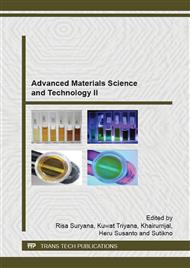[1]
K. H. Brosnan, G. L. Messing, D. K. Agrawal, , Microwave Sintering of Alumina at 2. 45 GHz, J. of the Am. Cer. Soc. 86 (2003) 1307–1312.
DOI: 10.1111/j.1151-2916.2003.tb03467.x
Google Scholar
[2]
M.A. Janney, et al., Microwave Processing of Materials II, Materials Research Society Proceeding. 189 (1990), 215 -228.
Google Scholar
[3]
Y. L. Tian, D. L. Johnson, M. E. Brodwin, Ultrafine Microstructure of Al2O3 Produced by Microwave Sintering, Ceramic Powder Science II B. Cer. Trans. 1, Am. Cer. Soc,. Ed. by G. L. Messing, E. R. Fuller, and H. Hausner. pp.925-932(1988).
Google Scholar
[4]
I. N. Sudiana, Ryo Ito, S. Inagaki, K. Kuwayama, K. Sako, S. Mitsudo, Densification of Alumina Ceramics Sintered by Using Sub-millimeter Wave Gyrotron, Int. J. of Infrared, Millimeter, and Terahertz Waves. 34 (2013) 627-638.
DOI: 10.1007/s10762-013-0011-6
Google Scholar
[5]
M. P. Harmer and R. J. Brook, Fast Firing-Microstructural Benefits, Trans. Brit. Ceram. Soc., 80.
Google Scholar
[5]
pp.147-148 (1981).
Google Scholar
[6]
J. Cheng, D. Agrawal, Y. Zhang, B. Drawl, and R. Roy, Fabricating Transparent Ceramics by Microwave Sintering, Amer. Ceram. Soc. Bull., 79.
Google Scholar
[9]
pp.71-74(2000).
Google Scholar
[7]
J. D. Katz and R. D. Blake, Microwave Sintering of Multiple Alumina and Composite Components, " Am. Ceram. Soc. Bull., 70.
Google Scholar
[8]
pp.1304-1308 (1991).
Google Scholar
[8]
S. Mitsudo, K. Sako, S. Tani, I.N. Sudiana, High Power Pulsed Submillimeter Wave Sintering of Zirconia Ceramics, The 36th IRMMW-THz 2011, USA, October 2-7, (2011).
DOI: 10.1109/irmmw-thz.2011.6105135
Google Scholar
[9]
H. Aripin, S. Mitsudo, E. S. Prima, I. N. Sudiana, S. Tani, K. Sako, Y. Fujii, T. Saito, T. Idehara, S. Sano, B. Sunendar, S. Sabchevski, Structural and Microwave Properties of Silica Xerogel Glass-Ceramic Sintered by Sub-millimeter Wave Heating using a Gyrotron, Int. J. of Infrared, Millimeter, and Terahertz waves. 33 (2012).
DOI: 10.1007/s10762-012-9925-7
Google Scholar
[10]
I. N. Sudiana, R. Ito, K. Sako, K. Kuwayama, S. Mitsudo, T. Idehara, Submillimeter Waves Sintering of Alumina Ceramics, The 4th International Workshop on Far-Infrared Technologies 2012, 7-9 March 2012, Fukui, Japan (2012).
DOI: 10.1109/irmmw-thz.2012.6380190
Google Scholar
[11]
I. N. Sudiana, R. Ito, K. Sako, K. Kuwayama, and S. Mitsudo, Effect of Initial Packing on Sub-Millimeter Waves Sintering of Alumina, IRMMW-THz 2012, September , Wollongong, Australia.
DOI: 10.1109/irmmw-thz.2012.6380190
Google Scholar
[12]
S.L.J. Kang, Sintering, Densification, Grain Growth and Microstructure, Elsevier, (2005).
Google Scholar
[13]
W. D. Kingery, H. K. Bowen, D. R. Uhlmann, Introduction to Ceramics, John Wiley, NewYork (1976).
Google Scholar
[14]
S. Mitsudo, H. Hoshizuki, T. Idehara, T. Saito, Development of material processing system by using a 300 GHz CW gyrotron, J. of Phys.: Conference Series. 52 (2006)549 – 552.
DOI: 10.1088/1742-6596/51/1/124
Google Scholar
[15]
W. Kingery, Structure and Properties of MgO and Al2O3 Ceramics, Advances in Ceramics Vol. 10, American Ceramic Society (1984).
Google Scholar
[16]
J.H. Booske, R.F. Cooper, I. Dobson, L. McCaughan, Model of Non-thermal Effect on Ionic Mobility During Microwave Processing of Crystalline Solids, Microwaves: Theory and Application in Material Processing, Cer. Trans. 21, Am. Cer. Soc., Ed. by D. E Clark, F.D. Gac, and W.H. Sutton , p.137(1991).
Google Scholar
[17]
T.T. Meek, Proposed Model for The Sintering of a Dielectric in a Microwave Field, J. Material Science Letters Vol. 6, pp.638-640(1987).
Google Scholar
[18]
V.E. Semenov and K.I. Rybakov, What Type of Transport Phenomena can be inducted by Microwave Field in Solids and How These Phenomena Contribute to Materials Processing, Proc. MAPEES`04, pp.111-117(2004).
DOI: 10.1016/b978-008044504-5/50022-2
Google Scholar
[19]
K.I. Rybakov, V.E. Semenov, G. Link, M. Thumm, Preferred orientation of pores in ceramics under heating by a linearly polarized microwave field, J. Appl. Phys. 101, 084915 (2007).
DOI: 10.1063/1.2723187
Google Scholar


